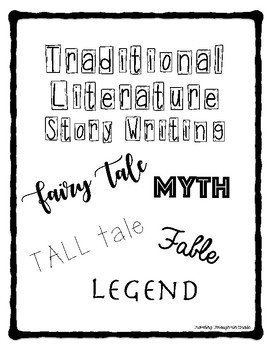Traditional Literature Folktale Writing (Common Core Aligned)
Traveling Through 4th Grade
1 Follower
Grade Levels
3rd - 8th
Subjects
Resource Type
Standards
CCSSRL.3.4
CCSSRL.4.4
CCSSRL.5.4
CCSSRL.6.4
CCSSRL.7.4
Formats Included
- PDF
Pages
8 pages
Traveling Through 4th Grade
1 Follower
Description
Understanding the FIVE types of Folktales can be extremely confusing for students! This resource gives students the opportunity to CREATE their own type of folktale! Creation is Depth of Knowledge Level 4 and the highest level of Bloom's Taxonomy. This resource guides students on how to write their chosen folktale STEP-BY-STEP.
Step-by-Step Instructions for how to write all of the FIVE FOLKTALES:
FABLE
FAIRY TALE
LEGEND
MYTH
TALL TALE
Also included in this resource is a template for students to create their OWN RUBRIC (Student-created rubric = Danielson Distinguished) In my classroom, I grouped students who chose to write the same type of folktale and had them decide on what categories they must include within their story and should therefore be on their rubric.
Rubrics for EACH folktale are INCLUDED!
Step-by-Step Instructions for how to write all of the FIVE FOLKTALES:
FABLE
FAIRY TALE
LEGEND
MYTH
TALL TALE
Also included in this resource is a template for students to create their OWN RUBRIC (Student-created rubric = Danielson Distinguished) In my classroom, I grouped students who chose to write the same type of folktale and had them decide on what categories they must include within their story and should therefore be on their rubric.
Rubrics for EACH folktale are INCLUDED!
Total Pages
8 pages
Answer Key
N/A
Teaching Duration
N/A
Report this resource to TPT
Reported resources will be reviewed by our team. Report this resource to let us know if this resource violates TPT’s content guidelines.
Standards
to see state-specific standards (only available in the US).
CCSSRL.3.4
Determine the meaning of words and phrases as they are used in a text, distinguishing literal from nonliteral language.
CCSSRL.4.4
Determine the meaning of words and phrases as they are used in a text, including those that allude to significant characters found in mythology (e.g., Herculean).
CCSSRL.5.4
Determine the meaning of words and phrases as they are used in a text, including figurative language such as metaphors and similes.
CCSSRL.6.4
Determine the meaning of words and phrases as they are used in a text, including figurative and connotative meanings; analyze the impact of a specific word choice on meaning and tone.
CCSSRL.7.4
Determine the meaning of words and phrases as they are used in a text, including figurative and connotative meanings; analyze the impact of rhymes and other repetitions of sounds (e.g., alliteration) on a specific verse or stanza of a poem or section of a story or drama.





